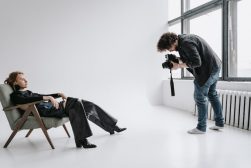
Guide to Black and White Portrait Photography
Create powerful, stunning and dramatic black and white portraits with these 8 tips for beginners. Improve your B&W portrait photography in 2023.
This guide to black and white portraits will give you all the tools you need to create stunning monochrome portrait photos.
We’ll also examine why you might choose black and white portraits over color.
We see color in everyday life, and a never-ending succession of color photos in the media bombards us.
Look at advertising examples on television and in print; they are almost universally in color.
So, due to their non-conformity, black and white photos stand out from the crowd – while also reminding us of previous eras.
Importantly, black and white portraits can open up a new world of sophisticated cool to your photography.
Whether you’re a black-and-white portrait photographer, someone interested in the simplicity of B&W, or even someone who shoots another type of portrait altogether, you’ll gain plenty of inspiration from this article.
So let’s get stuck in.
Why Shoot Black and White Portraits?
You may have found yourself at times asking the question: why do photos look better in black and white? To answer this question, it’s useful to briefly look at black and white photography compared to color photography.
For ‘serious’ photographers, black and white was the predominant photography mode until very recently, in relative terms. Kodak invented the first color film in 1935, but it was not until the 1970s that color photography really began to be recognised as an ‘art form’.
Color photography wasn’t widely used until the 1950s and to begin with, it was seen as being primarily for snapshots or adverts – not for serious or artistic photography.
In fact, it was one exhibition at the Museum of Modern Art in 1976, by William Eggleston, that helped challenge the norm and propel color photography to where it is today.
Since Eggleston’s intervention over 40 years ago, color photography has rapidly overtaken black and white photography to become the obvious choice for all kinds of photographers from fine art, to photojournalism, to wildlife.
However, despite this and even though black and white seems to be a retrograde stylistic step, black and white is still a choice for many photographers, including those who shoot portraits. But why shoot black and white portraits?
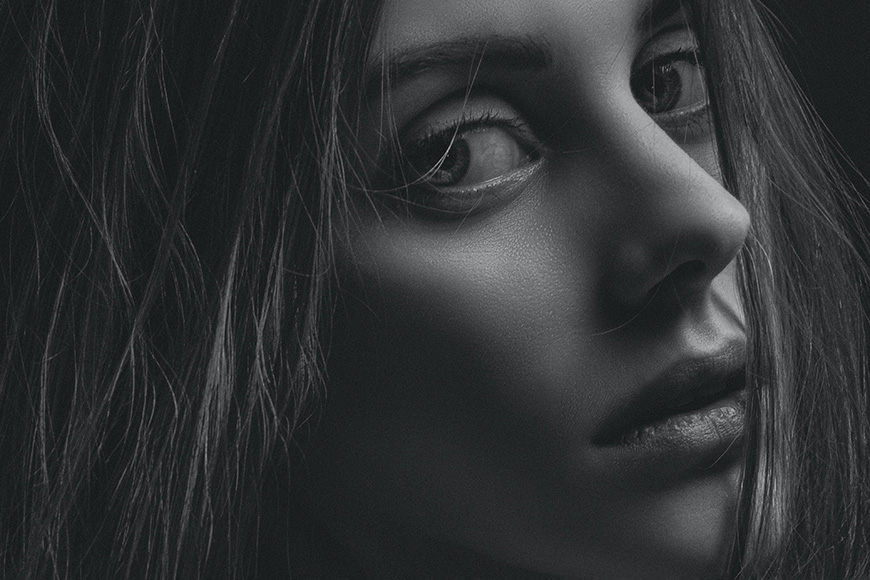
Credit: Alexander Krivitskiy
Firstly, there is an aesthetic appeal: black and white photos can look startling pure and sophisticated. This is really befitting for B&W portrait photos, or even when using monochrome or grayscale.
Its simplicity brings advantages: in black and white, the tonal range and contrasts can be manipulated without color interference.
By taking away the color, you remove one layer of distraction from the photo revealing, for instance, form and lighting in a new, clearer way – so important when you want to draw the eye to your subject.
Lastly, there is contingency: sometimes a color photo just doesn’t look right or looks awkward. Convert the photo to black and white and, the problem may go away – the imperfections of the original photo becoming an area fitting with the tonal spectrum of the rest of the face.
Now you may be asking: why are black and white portraits beautiful?
Well, black and white photography certainly can be beautiful. It references a century and half of stunning black and white photographic portraits and our cultural sense of beauty.
By concentrating on the B&W tonal range and the light and form it makes a statement of how the photographer sees the world – not simply what the camera records. In terms of black and white portrait photography, we observe how the photographer sees the model.
Also, black and white portraits can often reveal or accentuate emotional expressions to greater effect. As the great Canadian photographer Ted Grant said, “When you photograph people in colour, you photograph their clothes. But when you photograph people in black and white, you photograph their souls.”
How Much Do You REALLY Know About Photography?! 🤔
Test your photography knowledge with this quick quiz!
See how much you really know about photography...

(See more famous photography quotes here.)
Overall, we call it ‘black and white’, though the photos are actually, for the most part, grey – many shades of grey.
When you think about it, grey photos shouldn’t work. However, their tonal clarity makes black and white photos so distinct and so telling when used for portrait photography.
How to decide between Color vs Black and White Portraits
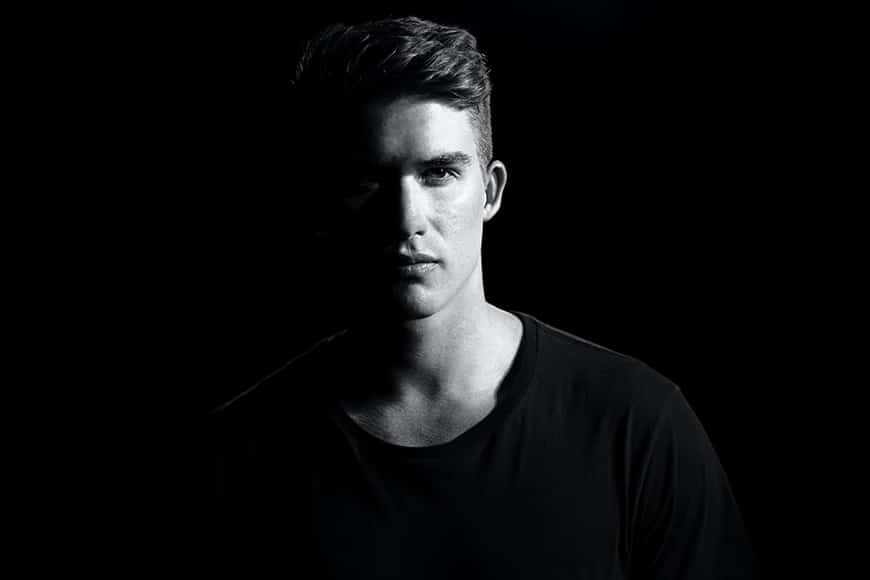
Credit: Christopher Campbell
In the end, this can be a stylistic choice – or it can be one of necessity. You may wish to choose black and white portraits to create striking photos.
You can use continuous lighting or a flash to help you achieve this – or even window light. However, you choose to create your photo though, pre-visualisation is key to good portrait photography of any kind.
This goes for how you will light your photo, frame and compose it, pose it and lastly – can extend to how you will edit it. Will it be a black and white portrait or color?
When deciding this with portraiture, there are certain things to think about.
First, consider whether depicting color is vital to who you are photographing. Do they have brightly colored hair, vivid or distinctly colored clothes?
Then, think about the background or the location – is the color within these elements important to the photo you are taking?
If the answer to these questions is no, then you may wish to try black and white portrait photography. As black and white really make the most of the subject – it removes distractions.
Another important consideration is that of mood and atmosphere. Black and white portraits are often associated with a sombre or bleak mood – however, that doesn’t have to be the case.
A black and white portrait can add drama – and you can use it alongside light and shadows to really up the contrast in the photo. This can, in turn, help isolate the subject in the photo– drawing the eye to the model and what you want to say with your image.
Should I shoot in black and white or convert later?
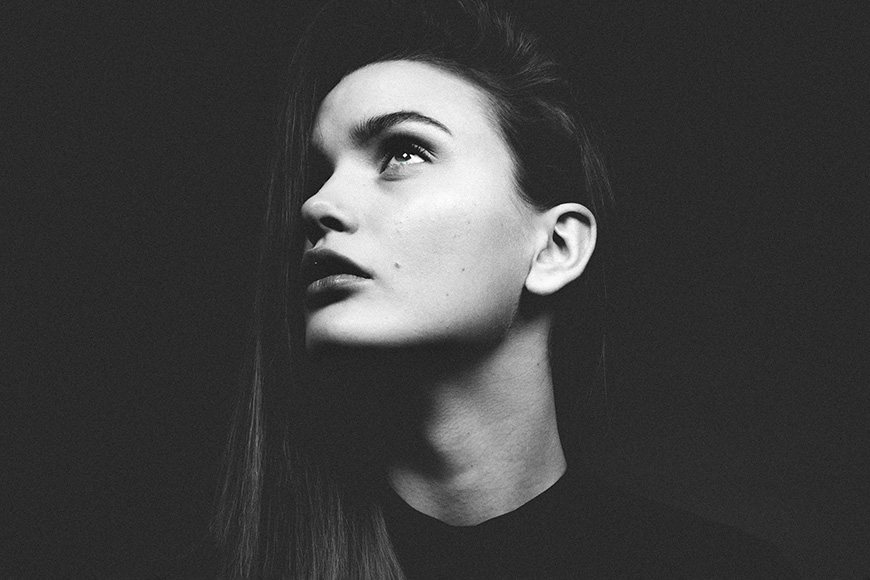
Credit: Peter Sjo
Shooting in black and white in-camera can give a quick result without the need for post-production work.
However, it’s important to realise that the camera – which may give you several black and white options, uses a pre-set algorithm (a fixed choice of filters and settings) to arrive at the final image.
Some cameras offer sophisticated options for capturing black and white in-camera– the principle of these being Leica’s M Monochrom cameras (these models shoot only in black and white, producing stunning results).
These however come at a price that prohibits even most professional photographers from purchasing what seems a rather niche item.
In most cameras, shooting black and white in-camera removes you from the process and takes away your ability to fine-tune the photo and allows technical and aesthetic decisions. In short, it gives an adequate, but what may be an arbitrary result.
Shooting ‘for’ black and white is something different – by this, we mean taking an image as a normal color digital file knowing that you will then convert it to black and white. Shooting in color and then taking the images into post-production opens up your options.
Lightroom, Photoshop and other editing software all provide conversion tools and processes to work with.
It’s worth remembering that if you shoot in black and white, you can’t add the color back in later, but you have both options available if you shoot in color.
You can use post-production conversion tools to change colors to black and white, enabling you to manipulate the tones and tonal spectrum.
Many photographers prefer to use the ‘Black and White’ toolset, which gives adjustments to the black and white photo through color filters.
It may be a little surprising that color filters play a part in black and white images; best to try it out and see what happens as you make choices and manipulate the sliders.
Before trying the color filter sliders try out the ‘Default’ solutions which will give you an idea of the huge range of possibilities.
When you first do black and white post-production work, choose images that aren’t too complex. The sliders are like filters and affect the corresponding color areas of the image. Moving them can affect texture, intensity and tone in black and white images.
Look carefully at highlights, mid-tones and dark areas of the image as you move one filter at a time.
8 Tips for Stunning Black and White Portraits
1. Choose a wide aperture to draw the eye to the subject
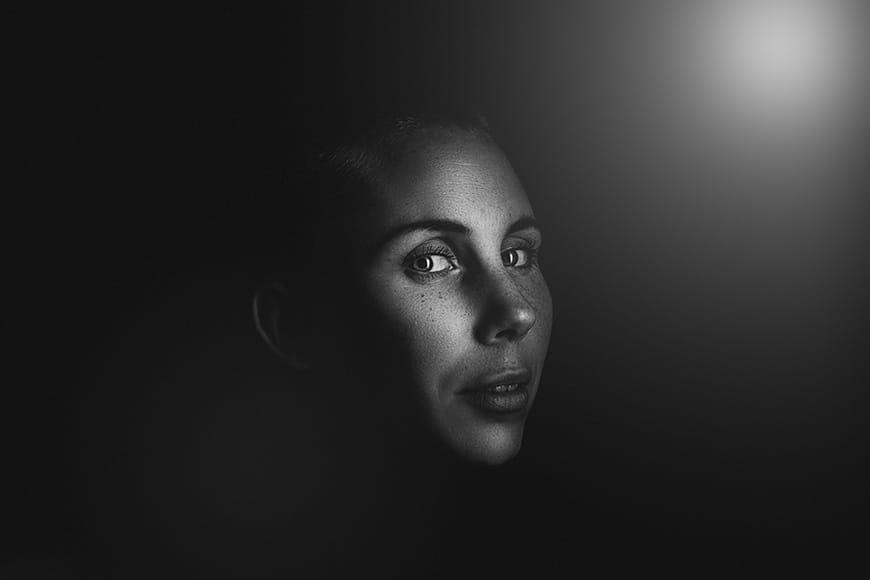
Credit: Janko Ferlic
If you’re looking to have bokeh in your black and white portraits or make the focal point of your image stand out – for example, the subject’s eye – choose a wide aperture such as f/1.4 to f/2.5.
This can also make your subject standoff a softened background.
If you have a sharp focus on the person’s eye at wide aperture, it will also soften the face’s features. It can also look really pleasing in black and white – and be extremely effective too, as, without color, you must be the one to decide how to separate the subject from the background.
Of course, you don’t have to shoot with a narrow aperture, but it is well worth trying when shooting black and white portraits.
Check out our guide to the best portrait lenses to learn more.
2. Use ISO to create a classic look
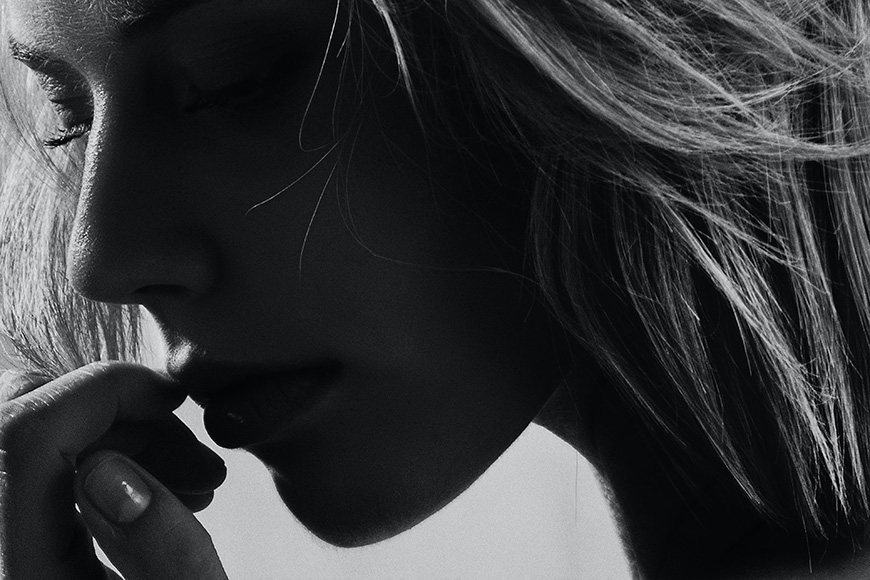
Credit: Alexander Krivitsk
High ISO is something you will no doubt try to avoid in most cases. It creates noise and can also, at very high iso, lessen the sense of sharpness, contrast and clarity in an image.
However, in black and white portrait photography, high ISO needn’t be such a problem. Also, it may even be a choice you make.
Converting a high ISO color image – full of noise – to black and white can be far more forgiving. It can suddenly make an image you might pass by into one you want to edit and keep.
The noise stays as it is – digital noise. But in black and white portrait photography, this noise begins to appear as grain, just like in a film photograph. So, the ‘grain’ adds a classic black and white look to your image.
So next time you’re shooting a portrait, why not try upping the ISO on your camera. You can create a grainy and classic looking black and white portrait – you always have apps to help reduce the noise if it becomes too overwhelming.
3. Shoot in RAW
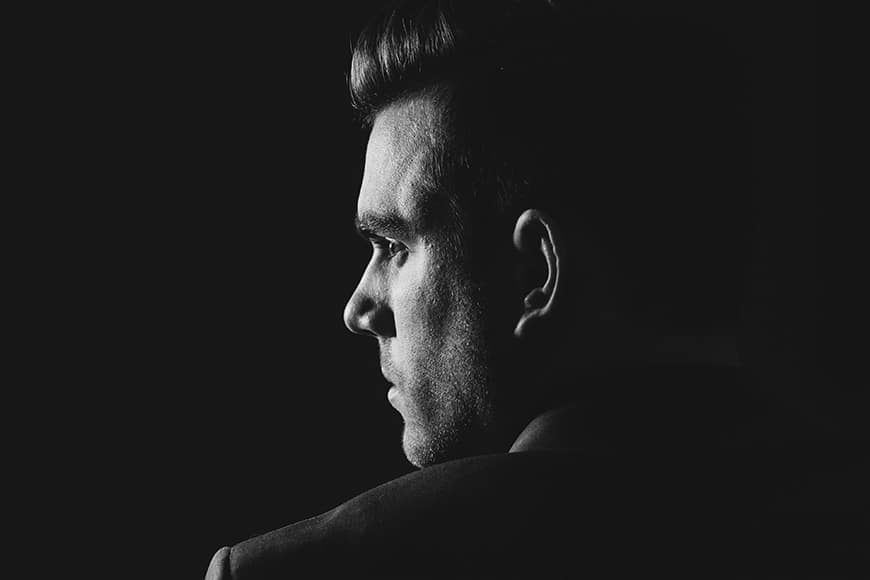
Credit: Drew Hays
As we’ve already discussed, for most cameras, it’s best to shoot in color with a view to converting black and white later, for the best tonal results.
To enable the most manipulation of your photo, we recommend you shoot in RAW.
Even when looking to create a black and white portrait, RAW is still the best choice. It gives you the most control over your photos and gives you the best chance of enhancing it even after converting to black and white.
4. Use negative space for a striking portrait
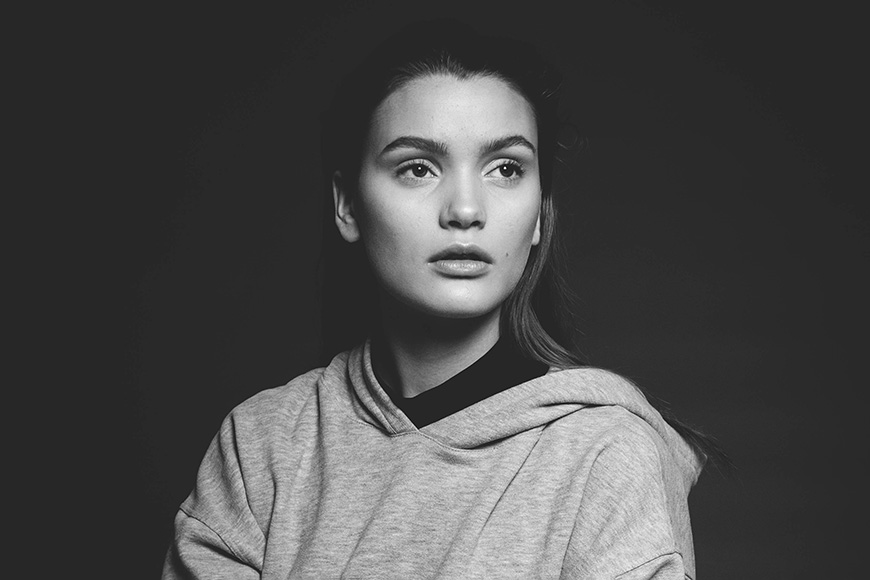
Credit: Peter Sjo
A black and white portrait can simplify the image in many ways, by taking away distractions from the subject. You can further make the image ‘all about the subject’ with the use of negative space.
Use a blank background – it can be any color or hue from white to black – and surround your model with negative space. Try composing your image differently. Use the rule of thirds, or place them centrally surrounded on either side by space.
Whatever compositional choice you make, by using negative space in a black and white portrait, you really reduce the image down to just the camera, the photographer and the model. You can then make the image all about the subject.
5. Choose your pose carefully

Credit: Shahin Khalaji
It may seem natural to go down a dramatic and atmospheric route when trying out black and white portrait photography. However, you can choose to elicit a more natural-looking portrait of your subject.
You can bring out humour or happiness in black and white images – it doesn’t have to be all film noir when going black and white! As we’ve said already, you can really focus in on what you want to say in black and white portrait photography.
If you want to photograph someone looking happy, black and white can accentuate this just as much as color photography can.
Using all the techniques we have discussed, you can draw the eye to a happy or laughing face, captured perfectly in black and white – just remember to direct your subject into a natural pose that’s fitting of your B&W concept.
6. Get your lighting set up right

Credit: Darius Bashar
Light is important for all kinds of photos, which is definitely true of black and white portrait photography. If you’re photographing a model on a black background, for example, there are ways to make the most of this setup.
Position your lighting source or flash to the side of the face. This will mean fewer light spills onto the background – it will also create a striking effect on the subject’s face.
Then you can adjust your camera settings, and you will find that you can get the exposure right so the person is well lit and the background is completely black.
If you don’t have a black photographic backdrop, why not try a black sheet.
7. Consider light and shade in your images
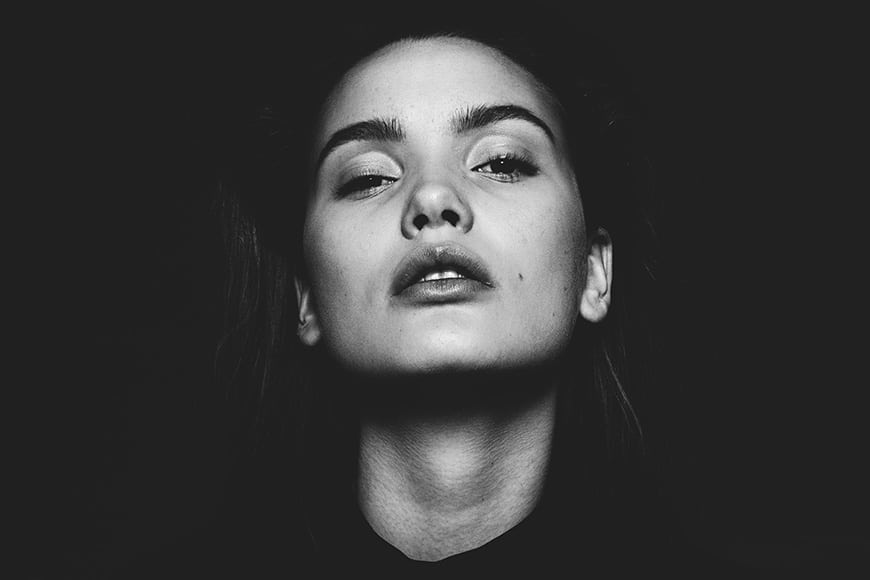
Credit: Peter Sjo
Light and shade can be increased in black and white portrait photography to great effect, both when taking the image and in the edit. In the edit, try pushing contrast and highlights.
You can also try dodging and burning while editing. This can be particularly effective in black and white portraiture as you seek to draw the viewer’s eye to certain areas of your image.
Dodge the highlight to make them brighter – or you can burn them to bring out detail.
Sometimes photographers worry that such techniques are somehow ‘cheating’ and you should get everything right ‘in camera’. However, don’t let yourself be shackled by thoughts like these.
Post-production has always been a part of photography – looking back, all the great photographers used every manipulation tool available to them while printing images in the darkroom.
As Ansel Adams said, “Dodging and burning are steps to take care of mistakes God made in establishing tonal relationships.”
8. Pick the perfect location

Credit: Christopher Campbell
If you choose to photograph your portrait outside, there are a few things to consider first. You might choose a brick wall or another wall, with added texture.
If you want to incorporate the background into your image, get your subject to stand against the wall – but if not, ask them to stand away from it.
Shooting underwater is also a good option, particularly as you don’t need to worry about the problems associated with white balance and color-correction.
Black and White Portrait Photography | Final Words
The world of black and white portrait photography is one of endless possibilities: an exploration of light and form; elegance and stunning detail; character expression; the aesthetics of ‘the cool’. The challenge is yours.
As Edward Weston said, “The camera should be used for a recording of life, for rendering the very substance and quintessence of the thing itself, whether it be polished steel or palpitating flesh,” or, we might add, portraits.
We hope this guide has been useful and given you a starting point to go out and try black and white portraits.
We hope the brief look back at why black and white is still as relevant today as it ever was – if not quite as prevalent in the mainstream – means it can be an important tool in your photographic toolbox.
If you have any questions at all, please leave them in the comments below, and we will get back to you as soon as possible.

Check out these 8 essential tools to help you succeed as a professional photographer.
Includes limited-time discounts.








